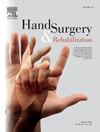全超声引导下桡骨神经松解的新技术。第一次经历。
IF 1
4区 医学
Q4 ORTHOPEDICS
引用次数: 0
摘要
Frohse桡神经压迫是一种罕见但重要的疾病,通常表现为前臂背侧疼痛,主要发生在劳累后和夜间,比网球肘疼痛更远,手腕伸肌和长指和拇指伸肌无力。传统的治疗方法通常包括开放手术,导致明显的疤痕。本文介绍了一种完全超声引导下经皮放射神经释放技术,并强调了其有效性和安全性。手术过程包括确定桡神经外侧的入路点,在不损伤附近血管或神经结构的情况下,有针对性地释放环绕旋后肌的浅筋膜。在10个新鲜冷冻标本上进行了尸体研究,以验证进入点和路径,成功地证明了完全的筋膜释放,没有并发症。5例患者的初步临床结果显示与桡骨隧道综合征相关的症状完全消退,无并发症报道。该技术的结果是切口明显变小(本文章由计算机程序翻译,如有差异,请以英文原文为准。
Radial nerve at Frohse's arcade: a new technique of release under total ultrasound guidance. First experience
Radial nerve compression at the arcade of Frohse is a rare but significant condition that typically presents with pain primarily after exertion and at night on the dorsal side of the forearm, more distally than tennis elbow pain, and weakness of the wrist extensors and the long fingers and thumb extensors. Traditional treatment often involves open surgery, resulting in significant scarring.
This study introduces a novel percutaneous radial nerve release technique under complete ultrasound guidance and highlights its efficacy and safety. The procedure involves identifying the entry point, lateral of the radial nerve, allowing for targeted release of the superficial fascia surrounding the supinator muscle without damaging nearby vascular or nerve structures.
A cadaveric study was performed on ten fresh-frozen specimens to validate the entry point and route, which successfully demonstrated complete fascial release without complications.
Preliminary clinical results from five patients showed complete resolution of symptoms associated with radial tunnel syndrome with no reported complications. The technique results in a significantly smaller incision (<1 cm) compared to traditional methods (up to 10 cm) and can be performed under WALANT anesthesia, making it suitable for the outpatient setting.
This approach offers a minimally invasive alternative for patients with isolated posterior interosseous nerve compression and highlights the importance of ultrasound guidance in achieving optimal results. Because the technique requires a learning curve, it is recommended for surgeons with experience in ultrasound-guided procedures.
求助全文
通过发布文献求助,成功后即可免费获取论文全文。
去求助
来源期刊

Hand Surgery & Rehabilitation
Medicine-Surgery
CiteScore
1.70
自引率
27.30%
发文量
0
审稿时长
49 days
期刊介绍:
As the official publication of the French, Belgian and Swiss Societies for Surgery of the Hand, as well as of the French Society of Rehabilitation of the Hand & Upper Limb, ''Hand Surgery and Rehabilitation'' - formerly named "Chirurgie de la Main" - publishes original articles, literature reviews, technical notes, and clinical cases. It is indexed in the main international databases (including Medline). Initially a platform for French-speaking hand surgeons, the journal will now publish its articles in English to disseminate its author''s scientific findings more widely. The journal also includes a biannual supplement in French, the monograph of the French Society for Surgery of the Hand, where comprehensive reviews in the fields of hand, peripheral nerve and upper limb surgery are presented.
Organe officiel de la Société française de chirurgie de la main, de la Société française de Rééducation de la main (SFRM-GEMMSOR), de la Société suisse de chirurgie de la main et du Belgian Hand Group, indexée dans les grandes bases de données internationales (Medline, Embase, Pascal, Scopus), Hand Surgery and Rehabilitation - anciennement titrée Chirurgie de la main - publie des articles originaux, des revues de la littérature, des notes techniques, des cas clinique. Initialement plateforme d''expression francophone de la spécialité, la revue s''oriente désormais vers l''anglais pour devenir une référence scientifique et de formation de la spécialité en France et en Europe. Avec 6 publications en anglais par an, la revue comprend également un supplément biannuel, la monographie du GEM, où sont présentées en français, des mises au point complètes dans les domaines de la chirurgie de la main, des nerfs périphériques et du membre supérieur.
 求助内容:
求助内容: 应助结果提醒方式:
应助结果提醒方式:


